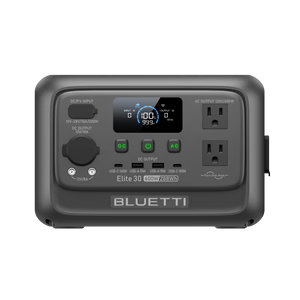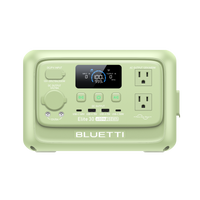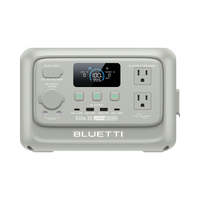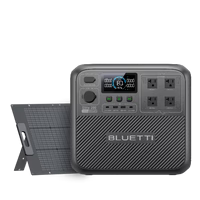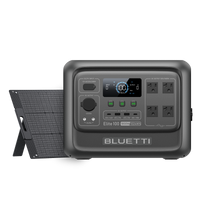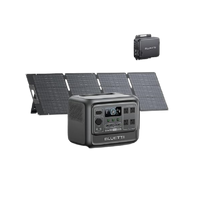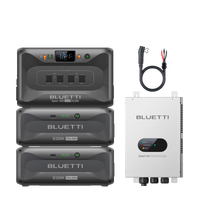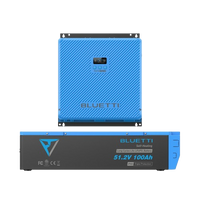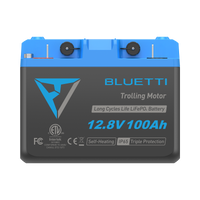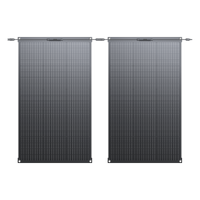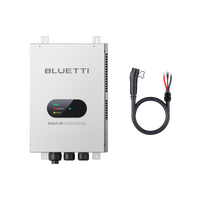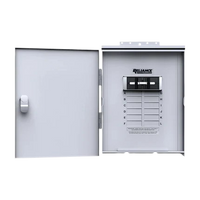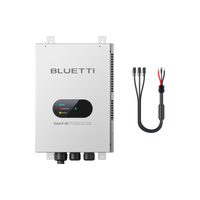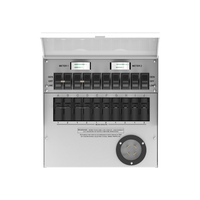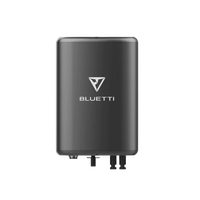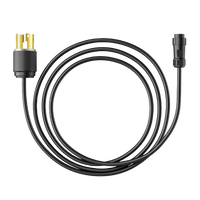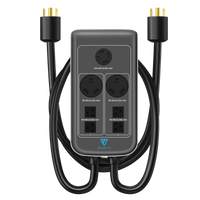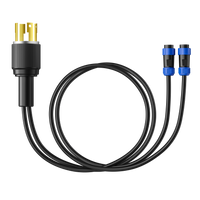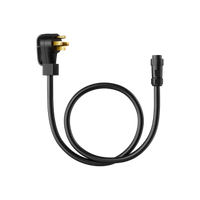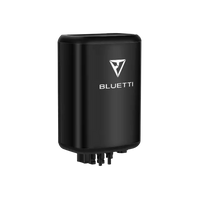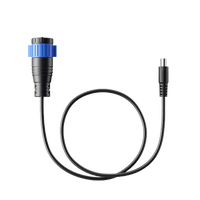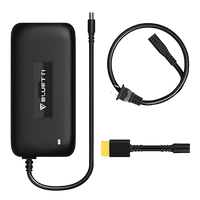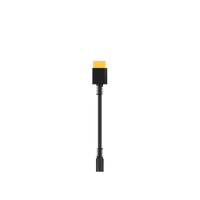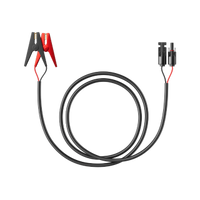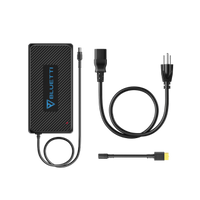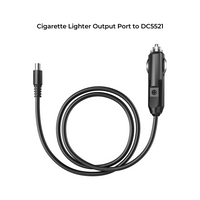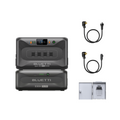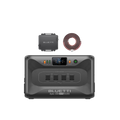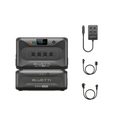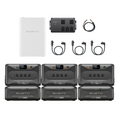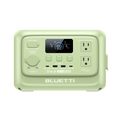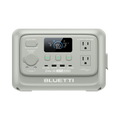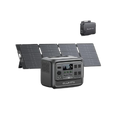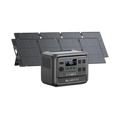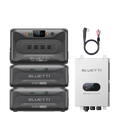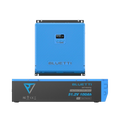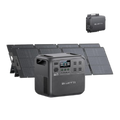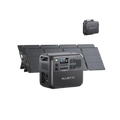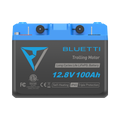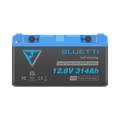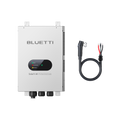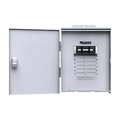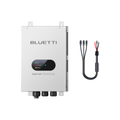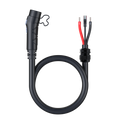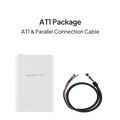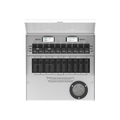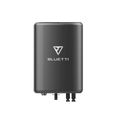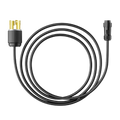La production cinématographique est une industrie réputée pour sa forte consommation d'énergie, notamment pour l'éclairage, le matériel sonore et autres équipements nécessaires. Cependant, face à l'intérêt croissant pour le développement durable et la réduction de l'empreinte carbone, de nombreuses productions cinématographiques se tournent vers l'énergie solaire pour couvrir leurs besoins énergétiques.
Les plateaux de tournage alimentés à l'énergie solaire gagnent en popularité car ils constituent une alternative durable aux sources d'énergie traditionnelles. Cet article explore les avantages de l'utilisation de panneaux solaires et de générateurs portables pour le cinéma et explique comment intégrer l'énergie solaire au processus de production cinématographique.
Avantages des plateaux de tournage alimentés à l'énergie solaire
Voici quelques-uns des principaux avantages de l'utilisation de panneaux solaires et de générateurs portables pour alimenter votre plateau de tournage.
1. Économies de coûts
L'un des principaux avantages de l'utilisation de l'énergie solaire pour la production cinématographique réside dans les économies réalisées. Les sources d'énergie traditionnelles peuvent s'avérer coûteuses, notamment sur de longues périodes. L'énergie solaire, quant à elle, est une source d'énergie gratuite et renouvelable qui permet de réduire considérablement les coûts énergétiques.
Les panneaux solaires et les générateurs peuvent alimenter l'éclairage, le matériel de sonorisation et d'autres équipements nécessaires, réduisant ainsi le recours aux générateurs coûteux ou au réseau électrique. De plus, le coût de la technologie solaire a diminué ces dernières années, la rendant plus accessible et plus économique pour la production cinématographique.
2. Réduction de l'empreinte carbone
La production cinématographique peut contribuer de manière significative aux émissions de gaz à effet de serre et au changement climatique. Cependant, les plateaux de tournage alimentés à l'énergie solaire offrent une alternative durable aux sources d'énergie traditionnelles, réduisant ainsi l'impact environnemental de la production cinématographique.
L'utilisation de l'énergie solaire permet aux productions cinématographiques de réduire considérablement leur empreinte carbone et de minimiser leur impact environnemental. Ceci est d'autant plus important que les consommateurs sont de plus en plus soucieux de l'environnement et recherchent des produits et services durables.
3. Portable et flexible
Les panneaux solaires et les générateurs portables sont légers et faciles à transporter, ce qui les rend idéaux pour les productions cinématographiques nécessitant des tournages en extérieur. Les panneaux solaires s'installent et se démontent facilement, et les générateurs peuvent être déplacés d'un lieu à l'autre, offrant ainsi une source d'énergie flexible et polyvalente.
Cette portabilité rend également l'énergie solaire idéale pour les productions cinématographiques qui se déroulent dans des lieux isolés ou des zones sans accès aux sources d'énergie traditionnelles.
4. Fiable
L'énergie solaire est une source d'énergie fiable, même dans les régions où l'accès à l'électricité est limité ou instable. Les panneaux et les générateurs solaires peuvent être chargés grâce à la lumière du soleil, ce qui leur permet de fournir de l'énergie même dans les zones dépourvues de réseaux électriques traditionnels.
Cela peut s'avérer particulièrement utile pour les productions cinématographiques se déroulant dans des régions isolées ou dans des endroits où l'alimentation électrique est instable ou peu fiable. Grâce à l'énergie solaire, les équipes de tournage peuvent rester connectées et productives quel que soit le lieu de tournage.
5. Réduction du bruit
Les générateurs traditionnels peuvent être bruyants et perturbateurs, notamment dans les zones résidentielles. En revanche, les générateurs solaires sont quasiment silencieux, ce qui en fait un choix idéal pour les tournages de films en milieu urbain ou résidentiel.
6.Évolutivité
Les systèmes d'énergie solaire peuvent être dimensionnés en fonction de l'envergure et de la complexité de la production cinématographique. Ainsi, les productions de moindre envergure, tout comme les productions plus importantes et plus complexes, peuvent bénéficier de l'énergie solaire.
7. Réduction du risque de pannes de courant
Les sources d'énergie traditionnelles peuvent être vulnérables aux coupures ou aux interruptions de courant, ce qui peut engendrer des coûts et des délais importants pour leur résolution. En revanche, l'énergie solaire est une source d'énergie fiable et constante, non affectée par les coupures ou les interruptions de courant.
8. Opportunités de stratégie de marque et de marketing
L'énergie solaire est un secteur en pleine expansion, et de nombreux consommateurs recherchent des produits et services durables. En intégrant l'énergie solaire à leurs productions, les cinéastes peuvent se démarquer de la concurrence et séduire une clientèle soucieuse de l'environnement.
Intégrer l'énergie solaire dans le processus de production cinématographique
Il existe de nombreuses façons d'intégrer l'énergie solaire au processus de production cinématographique. En voici quelques exemples :
1. Éclairage solaire
L'éclairage est l'un des aspects les plus énergivores de la production cinématographique. Cependant, l'éclairage solaire peut réduire considérablement les coûts énergétiques et les émissions de carbone.
L'énergie solaire permet d'éclairer des espaces extérieurs ou de compléter les sources d'éclairage traditionnelles. L'éclairage LED, en particulier, est économe en énergie et peut être alimenté par des panneaux solaires ou des générateurs.
2. Équipement audio à énergie solaire
Les panneaux solaires ou les générateurs peuvent également alimenter du matériel audio, comme des microphones, des haut-parleurs et des appareils d'enregistrement. Ce type d'équipement permet de réduire considérablement les coûts énergétiques et de se passer des sources d'énergie traditionnelles.
3. Stations de recharge solaires
Les appareils numériques, tels que les appareils photo, les ordinateurs portables et les smartphones, consomment beaucoup d'énergie pour fonctionner. Les bornes de recharge solaires constituent une solution durable et pratique pour maintenir ces appareils chargés et alimentés.
Transport à énergie solaire
Les tournages de films nécessitent souvent d'importants moyens de transport, notamment des voitures, des camions et autres véhicules. Grâce aux transports alimentés à l'énergie solaire, tels que les véhicules électriques ou hybrides, vous pouvez réduire considérablement les émissions de carbone et proposer une alternative durable aux transports traditionnels sur votre plateau de tournage.

Comment choisir le bon système d'énergie solaire pour les plateaux de tournage ?
Lorsqu'il s'agit de choisir le système d'énergie solaire portable adapté à un plateau de tournage, plusieurs facteurs sont à prendre en compte. Voici quelques points clés :
1. Puissance de sortie
Lorsqu'on évalue la puissance nécessaire à l'installation d'un système d'énergie solaire portable sur un plateau de tournage, il est essentiel de bien comprendre les besoins énergétiques de la production. Cela inclut le nombre et le type d'équipements utilisés, ainsi que leur durée d'utilisation. Par exemple, un plateau de tournage utilisant principalement des éclairages LED et un petit nombre de caméras consommera moins d'énergie qu'un plateau utilisant de nombreux projecteurs, caméras et autres équipements puissants.
Une façon d'estimer les besoins en énergie de la production cinématographique consiste à utiliser un calculateur de puissance.Cet outil permet aux cinéastes de déterminer la puissance totale (en watts) de tout le matériel utilisé, afin de calculer la puissance minimale requise pour le système solaire. Il est important d'ajouter une marge de sécurité au calcul pour tenir compte des surtensions imprévues ou de l'ajout de matériel en cours de production.
2. Portabilité
Les tournages de films se déroulant souvent en extérieur, il est important de choisir un système solaire portable et facile à transporter. Privilégiez les systèmes légers et compacts, munis de poignées ou d'une housse de transport.
3. Capacité de la batterie
La capacité de la batterie est un critère essentiel lors du choix d'un système d'alimentation solaire portable pour un tournage. Si la puissance de sortie détermine la quantité d'énergie pouvant être générée instantanément, la capacité de la batterie détermine l'autonomie du système sans recharge.
La capacité de la batterie d'un système d'énergie solaire portable se mesure en ampères-heures (Ah) ou en wattheures (Wh). Une batterie de grande capacité peut stocker davantage d'énergie et fournir de l'énergie plus longtemps. Pour les productions cinématographiques nécessitant une alimentation électrique prolongée, il est essentiel de choisir un système doté d'une batterie haute capacité capable de fournir de l'énergie pendant plusieurs heures, voire plusieurs jours.
4. Temps de charge
Le temps de charge du système solaire est également un critère important. Privilégiez les systèmes qui se rechargent complètement en un temps raisonnable, en fonction de l'ensoleillement. Certains systèmes se rechargent en quelques heures seulement, tandis que d'autres peuvent nécessiter une journée entière, voire plus.
5. Durabilité
Les tournages de films étant souvent imprévisibles et se déroulant dans des environnements variés, il est essentiel de choisir un système solaire robuste, capable de résister aux intempéries. Privilégiez les systèmes étanches, résistants aux chocs et à la poussière, dotés d'une construction solide et fabriqués avec des matériaux de haute qualité.
6. Prix
Il est important de prendre en compte le prix du système solaire. Bien que les systèmes solaires portables puissent représenter un investissement conséquent, ils peuvent également générer des économies à long terme et des avantages environnementaux. Il convient donc d'opter pour des systèmes offrant un bon compromis entre fonctionnalités et prix, et de considérer les économies à long terme sur le carburant et autres coûts énergétiques.
En tenant compte de ces facteurs, les cinéastes peuvent choisir le système d'énergie solaire portable adapté à leur plateau de tournage, leur fournissant une alimentation électrique durable et fiable pour leurs besoins de production.
7. Compatibilité avec les équipements
Il est important de s'assurer que le système d'énergie solaire portable est compatible avec le matériel utilisé sur le plateau de tournage. Certains équipements peuvent nécessiter une tension ou une puissance spécifique ; il est donc essentiel de choisir un système solaire capable de répondre à ces exigences.
8. Extensibilité
Si la production cinématographique est amenée à prendre de l'ampleur, il est important de choisir un système solaire facilement extensible ou modernisable. Privilégiez les systèmes permettant l'ajout de panneaux solaires ou de batteries supplémentaires afin de pouvoir adapter le système à l'évolution des besoins de la production.
9. Facilité d'utilisation
Le système solaire doit être facile à installer et à utiliser, même pour ceux qui ne connaissent pas la technologie solaire.Choisissez des systèmes dotés d'instructions claires et d'interfaces conviviales avec des commandes et des affichages intuitifs.

Conclusion
En conclusion, les plateaux de tournage alimentés à l'énergie solaire offrent une alternative durable et économique aux sources d'énergie traditionnelles pour la production cinématographique. L'intégration de panneaux solaires et de générateurs portables dans le processus de production permet de réduire considérablement l'empreinte carbone et l'impact environnemental des films. Ceci est particulièrement important dans un secteur reconnu pour sa forte consommation énergétique et son impact environnemental significatif.
Les plateaux de tournage alimentés à l'énergie solaire sont non seulement écologiques, mais ils offrent également aux cinéastes une occasion unique de promouvoir le développement durable et de sensibiliser le public aux enjeux environnementaux. En intégrant l'énergie solaire à leurs productions, les cinéastes peuvent démontrer leur engagement en faveur du développement durable et inciter d'autres personnes à adopter des choix plus respectueux de l'environnement.
Découvrez ici quelques-uns des meilleurs produits d'énergie solaire, notamment des panneaux solaires portables et des générateurs solaires portables, pour alimenter votre plateau de tournage.






